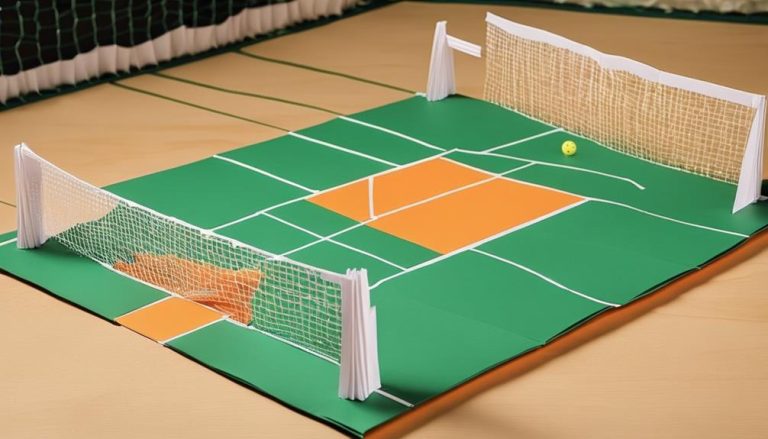General Rules of Playing Valencian Frontó
Imagine yourself stepping onto the vibrant court of Valencian Frontó, the air filled with anticipation. You are about to embark on a thrilling journey into the world of this unique sport. In this article, we will unravel the general rules that govern the game, guiding you through the dimensions of the court, player positions, and the art of serving. Get ready to immerse yourself in the exhilarating world of Valencian Frontó, where victory awaits those who embrace the challenge.

Valencian Frontó is a traditional sport that originated in the Valencian Community of Spain. It is a fast-paced and dynamic game that combines elements of handball, tennis, and squash. Played on a rectangular court with a front wall, Valencian Frontó requires agility, strategy, and precision.
The court dimensions vary depending on whether it is an indoor or outdoor game. In indoor Frontó, the court is 30 meters long and 10 meters wide, while outdoor Frontó has a length of 54 meters and a width of 10 meters. The front wall is made of granite and has three horizontal lines that divide it into different sections.
The game is played between two teams, each consisting of two players. The objective is to hit the ball against the front wall in a way that makes it difficult for the opposing team to return it. The ball must be struck with an open hand or a racket, depending on the variant of Frontó being played.
Serving is a crucial aspect of Valencian Frontó. The server must hit the ball against the front wall, ensuring it lands within a designated area. The receiving team must then return the ball before it bounces twice on the ground. Points are awarded when a team fails to return the ball successfully or commits a fault.
Now that you have a glimpse into the thrilling world of Valencian Frontó, let’s dive deeper into its rules and strategies. By understanding the intricacies of this sport, you will be well-equipped to enjoy and excel in the game. So, grab your racket, step onto the court, and let the excitement of Valencian Frontó unfold before you.
Court Dimensions and Layout
To understand the game of Valencian Frontó, you need to familiarize yourself with the dimensions and layout of the court. Court maintenance is crucial to ensure a fair and safe playing environment.
The court is rectangular, measuring 54 meters in length and 10 meters in width. The front wall, also known as the frontis, is located at one end of the court and stands 10 meters high. It’s made of concrete or similar materials, providing a solid surface for the game.
The frontis is divided into three sections: the top, middle, and bottom. The top section, known as the llotgeta, is where the ball must hit in order to score points. It’s marked with a horizontal line that’s 8 meters above the ground. The middle section, called the rebot, is located below the llotgeta and is used for rebounding the ball. The bottom section, known as the raspall, is the lowest part of the frontis. It’s mainly used for defensive shots that bounce low.
To maintain the court, regular inspections should be conducted to check for any cracks or damage on the frontis. Any necessary repairs should be promptly carried out to ensure the safety of the players. Additionally, the court surface should be kept clean and free from any debris that may affect the ball’s bounce or players’ movements.
Equipment needed for playing Valencian Frontó includes a leather ball, called a pilota, and a racket-like instrument, known as a pala. The pilota is smaller and harder than a traditional tennis ball, allowing for faster play. The pala has a flat, solid surface that’s used to strike the ball against the frontis. It’s important to use a pala that’s of good quality and properly maintained to enhance performance and prevent injuries.
Player Positions and Responsibilities
As a player of Valencian Frontó, your position and responsibilities on the court are crucial for the success of the game. To ensure effective gameplay, player rotation and substitutions are essential. This allows for fresh players to be on the court, maintaining energy levels and preventing fatigue. Communication and teamwork among players are also vital aspects of the game. By effectively communicating with your teammates, you can strategize, coordinate movements, and execute plays seamlessly. This fosters a sense of belonging and unity within the team.
The table below provides an overview of the player positions and their corresponding responsibilities:
| Position | Responsibilities |
|---|---|
| Front | • Serve the ball |
• Return the ball
• Aim for the front wall |
| Back | • Assist the front player
• Cover the backcourt
• Return balls that rebound off the back wall |
| Middle | • Support both the front and back players
• Cover the middle of the court
• Assist in returning balls from both sides |
| Side | • Assist the front player
• Cover the side walls
• Return balls that rebound off the side walls |
| Substitute | • Be ready to replace a player when needed
• Maintain readiness and focus throughout the game
• Provide support and encouragement to teammates |
Serve and Serve Reception
Your serve and serve reception are crucial aspects of playing Valencian Frontó. Mastering the serve technique and placement can greatly impact your performance in the game. Here are some key points to keep in mind:
-
Serve technique:
-
Grip the ball firmly with your dominant hand, ensuring a secure hold.
-
Stand with your feet shoulder-width apart and maintain a balanced stance.
-
Swing your arm forward in a controlled motion, releasing the ball at the peak of your swing.
-
Aim to serve the ball with enough power to make it difficult for your opponent to return.
-
Serve placement:
-
Strategically choose where to place your serve to gain an advantage.
-
Target areas that are hard for your opponent to reach or return.
-
Aim for corners, edges, or gaps in your opponent’s defense.
-
Vary your serve placement to keep your opponent guessing and off-balance.
By honing your serve technique, you can deliver powerful and accurate serves that put pressure on your opponent. Additionally, strategic serve placement can force your opponent into difficult positions and increase your chances of scoring points.
Practice your serve regularly to improve accuracy and control. Remember, a well-executed serve can set the tone for the entire game and give you the upper hand.
Keep these tips in mind and watch your serve and serve reception skills improve, allowing you to dominate the game of Valencian Frontó.
Scoring System and Winning Conditions
In Valencian Frontó, each shot is worth a certain number of points depending on where it lands.
The minimum score required to win a game is typically set at 25 points, but this can vary depending on the agreed-upon rules.
In the event of a tie, tie-breaking rules may come into play to determine the winner.
Points for Each Shot
To determine the points for each shot in Valencian Frontó, players must follow a specific scoring system and winning conditions. The scoring techniques and shot selection play a crucial role in earning points in this game. Here’s how the points are awarded:
-
Frontó: When the ball is hit against the front wall and it lands within the designated area, players earn 1 point.
-
Curtain: If the ball is hit against the side walls or the back wall without touching the ground, players score 2 points.
These scoring techniques require precision and accuracy in shot selection. Players must strategize their shots to maximize their chances of earning points. By understanding the scoring system and mastering the appropriate shot selection, players can gain an advantage and increase their chances of winning in Valencian Frontó.
Minimum Score to Win
To achieve victory in Valencian Frontó, players must reach a minimum score determined by the scoring system and winning conditions. The minimum score strategy is crucial for players to secure a win.
In Valencian Frontó, the minimum score required to win varies depending on the specific rules being followed. Generally, players aim to reach a predetermined number of points, such as 30 or 40, before their opponents.
To achieve this, players employ various scoring techniques, such as aiming for specific areas of the court or using strategic shots to maximize their point total. It’s important for players to carefully consider their scoring options and adapt their strategies accordingly.
Tie-Breaking Rules
Now, let’s delve into the tie-breaking rules that determine the winner in Valencian Frontó. In this game, if the scores are tied at the end, there are specific methods to break the tie. Here are the tie-breaking methods:
-
Points Difference: The player or team with the higher points difference is declared the winner. Points difference is calculated by subtracting the opponent’s score from your own.
-
Games Won: If the points difference is the same, the player or team who’s won more games throughout the match takes the victory.
These tie-breaking rules add an extra layer of excitement and strategy to Valencian Frontó. Players mustn’t only focus on scoring points but also consider their performance relative to their opponents. By employing effective game strategies, players can increase their chances of winning and come out on top in this thrilling sport.
Rules for Ball Contact and Shots
Make sure you use proper technique and aim when making contact with the ball and taking shots in Valencian Frontó. Ball control techniques are crucial in Valencian Frontó, as they allow you to maintain possession and create scoring opportunities. When receiving the ball, focus on using the inside or outside of your foot to control it, depending on the direction you want to send it. This will ensure that you have a good first touch and can quickly transition into your next move.
Shooting strategies are also important in Valencian Frontó. One common technique is the ‘picada,’ where you strike the ball with the top of your foot to create a high, looping shot that can surprise the opponent. Another technique is the ‘mijaillo,’ which involves striking the ball with the side of your foot to generate a powerful and accurate shot.
Aiming is crucial when taking shots in Valencian Frontó. You should always aim for the corners of the court, as this makes it harder for the opponent to defend. Additionally, it’s important to vary your shots and not become predictable. Mix up your shots by using different techniques and aiming for different areas of the court. This will keep the opponent guessing and increase your chances of scoring.
Fouls and Penalties
Now let’s talk about the points related to fouls and penalties in Valencian Frontó. Understanding the types of fouls and how the penalty enforcement process works is crucial to playing the game successfully.
Types of Fouls
Identify the various types of fouls and penalties in Valencian Frontó.
In Valencian Frontó, there are several common fouls that players should be aware of. These include:
-
Hitting the ball outside the court: If a player hits the ball out of the designated court area, it’s considered a foul.
-
Obstructing the opponent: Intentionally blocking the opponent’s movement or interfering with their ability to play the ball is also a foul.
Penalties for these fouls may include awarding points to the opposing team or giving the fouled team the opportunity to serve again. It’s important for players to understand these fouls and penalties to ensure fair play and maintain the integrity of the game.
Penalty Enforcement Process
To enforce penalties for fouls in Valencian Frontó, you should be familiar with the penalty enforcement process. When a player commits a foul, the referee will assess the situation and determine the appropriate penalty based on the severity of the offense. The penalty enforcement guidelines are designed to maintain fairness and sportsmanship in the game. Here is a breakdown of the consequences of penalties in Valencian Frontó:
| Penalty | Consequence |
|---|---|
| Minor foul | Loss of serve |
| Major foul | Loss of serve and point |
| Serious foul | Loss of serve and two points |
These penalty enforcement guidelines ensure that players are held accountable for their actions and discourage any unsportsmanlike behavior. By adhering to these rules, players can enjoy a fair and competitive game of Valencian Frontó.
Preventing Common Fouls
To prevent common fouls in Valencian Frontó, you should be aware of the rules and guidelines for avoiding penalties. Here are some tips to help you avoid making mistakes and improve your shot accuracy:
-
Common mistakes to avoid in Valencian Frontó:
-
Avoid stepping on the forbidden line before serving the ball.
-
Don’t obstruct your opponent’s shot by standing too close to the front wall.
-
Refrain from hitting the ball out of bounds or into the net.
-
Techniques for improving shot accuracy in Valencian Frontó:
-
Focus on your footwork to ensure proper positioning for each shot.
-
Practice your swing technique to develop a consistent and powerful shot.
-
Work on your timing to hit the ball at the right moment for maximum accuracy.
Time Limits and Game Duration
To ensure fair play and maintain a smooth flow of the game, it’s important to adhere to specific time limits and game durations when playing Valencian Frontó. Time management and game pace are crucial aspects of this sport, as they ensure that matches progress efficiently and keep players engaged.
In Valencian Frontó, each game is divided into sets, and each set is further divided into rounds. The duration of each set is typically predetermined, with the most common time limit being 45 minutes. This time limit ensures that the game doesn’t drag on unnecessarily and allows for multiple sets to be played within a reasonable timeframe.
Within each set, the duration of rounds can vary depending on the level of play and the players’ abilities. However, it’s generally recommended to allocate around 3 minutes for each round. This allows players enough time to strategize, execute shots, and react to their opponent’s moves, without delaying the game significantly.
In addition to these time limits, Valencian Frontó also enforces a rule called ‘time-saving.’ This rule is designed to prevent excessive delays and maintain a steady game pace. If a player takes longer than 45 seconds to serve the ball, a time-saving warning is issued. If the player continues to exceed the time limit, penalties may be imposed, such as loss of points or even disqualification.
Strategies and Tactics for Success
Maintaining a smooth flow of the game and adhering to specific time limits and game durations are essential for success in Valencian Frontó. However, to truly excel in this sport, you must also employ effective strategies and tactics.
Here are some techniques that can help you improve your game and increase your chances of success:
-
Serve Placement: Mastering the art of serving in Valencian Frontó is crucial. Aim to place your serve in areas that are difficult for your opponent to return. By strategically targeting the corners or the walls, you can put pressure on your opponent and gain an advantage from the start.
-
Shot Variety: Developing a diverse range of shots is key to keeping your opponent on their toes. Mix up your shots by incorporating lobs, hooks, and powerful drives. This unpredictability will make it harder for your opponent to anticipate your next move and give you an edge in the game.
-
Court Positioning: Pay close attention to your positioning on the court. Position yourself strategically to maximize your reach and cover more ground. By staying close to the walls and maintaining a strong defensive position, you can effectively counter your opponent’s shots and maintain control of the game.
-
Communication: Effective communication with your partner is vital in doubles matches. Coordinate your movements, communicate your intentions, and anticipate each other’s shots. This synergy can lead to seamless teamwork and ultimately result in a successful outcome.
Frequently Asked Questions
Are There Any Specific Rules Regarding the Attire or Equipment That Players Must Use in Valencian Frontó?
When playing Valencian Frontó, it’s important to follow certain rules regarding attire and equipment.
Attire requirements for players usually include comfortable clothing and appropriate footwear that allows for easy movement on the court.
As for equipment specifications, players typically use a special racket designed for Frontó, which is similar to a paddle but with a shorter handle.
Following these guidelines ensures a fair and enjoyable game for everyone involved.
Is There a Limit to the Number of Players That Can Be on a Team in Valencian Frontó?
In Valencian Frontó, the number of players on a team can vary depending on the game. Sometimes it’s one-on-one, other times it’s two-on-two. It’s all about finding the right balance and working together to outsmart your opponents.
Can You Explain the Concept of “Rebote” and How It Affects Gameplay in Valencian Frontó?
In Valencian Frontó, the concept of ‘rebote’ plays a crucial role in gameplay. ‘Rebote’ refers to the act of hitting the ball against the front wall in a way that it bounces back towards the opponent’s side.
This technique can be used strategically to gain an advantage, as it makes it harder for the opponent to return the ball. Skilled players employ various strategies and techniques to maximize ‘rebote’ and keep their opponents on their toes.
Are There Any Restrictions on Where Players Can Stand on the Court During Gameplay?
During gameplay in Valencian Frontó, there are certain restrictions on where players can stand on the court. These restrictions are in place to ensure fair play and proper court coverage.
Players must adhere to their designated positions and can’t cross over into their opponent’s territory. By strategically positioning themselves, players can maximize their court coverage and increase their chances of winning.
It’s important to understand these court positioning rules in order to effectively plan and execute gameplay strategies.
Is There a Specific Age Requirement for Players to Participate in Valencian Frontó?
To fully embrace the world of Valencian Frontó, it’s important to know if there’s a specific age requirement.
Imagine the joy a young child feels when they step onto the court, holding a racket for the first time.
The specific age requirement for Valencian Frontó varies, but starting at a young age has its benefits.
Playing early allows children to develop essential skills, foster teamwork, and build lifelong friendships.






